Roncalese identity: clothing in 19th century photographic portraits
JOSÉ IGNACIO RIEZU BOJ
In this virtual exhibition we would like to show a series of photographs, fifteen to be precise, that we have been collecting over several years, all dating from the 19th century and showing men and women dressed in Roncal costume. They represent important material for studying this attire in the second half of the 19th century.
The creation of photography was a long process involving a multitude of inventors, of different nationalities, who had very different successes. This lengthy birth gave rise to the creation of different photographic processes. Thus, the Frenchman Nicéphore Niepce developed the first photographs on Judea bitumen around 1826; the Brazilian Hercule Florence produced photographs in 1833; the Frenchman Hippolythe Bayard invented photogenic drawings in 1839; another Frenchman, Louis Daguerre, patented the daguerreotype in 1839; Englishman William Fox Talbot patented the calotype or talbotype in 1841; his compatriot John Herschel Atkins created the cyanotype in 1842; even a Spaniard, José Zanetti, has been recently illuminated as a creator of photographs around 1842. All these processes were expensive, laborious and required long exposures, which made them extremely difficult to use for personal portraits. The daguerreotype and the calotype were the methods that triumphed in the early days of portrait photography, but their high prices made them accessible only to the wealthiest social strata.
The invention in 1851 of a new photographic procedure called "wet collodion" by the Englishman Frederick Scott Archer and the Frenchman Gustave Le Gray was a great advance for photographic portraits and gave rise to new procedures such as the ambrotype or the ferrotype. But it was the appearance of the procedure called "Carte de Visite" (CDV) or "Portrait Cards", patented by the Frenchman André Adolphe Eugène Disdéri in 1854, which facilitated the access to portraits to a part of the society that had not enjoyed it until then. This procedure allowed several photographs (4, 6, 8 or 12) to be obtained on the same cliché, producing small photographs that were pasted on a cardboard the size of a visit card (hence the name, approximately 6.3 x .2 cm) for a modest amount of money. The numbered cliché was kept by the studio, which made it possible to make new copies without the sitter being present. This mass production of portraits made it possible for their owners to distribute their image among relatives or acquaintances, thus imitating the painted miniatures or daguerreotypes used by the aristocracy. It was also a form of distinction within an average social stratum, which could not leave access to these luxuries. The appearance of this procedure provoked the proliferation of photographic programs of study in small towns that nourished their income thanks to this more economical method. As the century progressed, new sizes of card appeared, increasing their size, such as the Victoria (8.3 x .2 cm), Cabinet (11 x cm), Promenade (10.8 x cm), Boudoir (13.4 x .5 cm), or the largest, the imperial (17.5 x cm), making the procedure more varied and luxurious. However, the most widespread sizes were the CDV and later the Cabinet or Cabinet in Spanish. The technique spread and became so popular that by 1860 it had reached photographic establishments all over the world.
Roncalese clothing has always been considered by the Roncalese to be something important and exclusive to the valley. In fact, in the different ordinances that the valley updated during the 16th, 17th and 18th centuries, there is always a chapter explaining and regulating its use only for people born in the valley. The exclusive use of the Roncal costume was a way of recognising and protecting the special individual privileges of the Roncals, including their collective nobility. This way of differentiating themselves from other foreign inhabitants and the privilege that this entailed may have been the origin of the strong bond that the Roncals have maintained with their costume and which has lasted until a few decades ago with more roots than in other valleys or villages in Navarre.
Roncal society in the 19th century suffered a major economic decline. The timber industry, which had enriched and provided work for the whole valley in the 18th century thanks to the demand for timber by the Spanish Navy, succumbed to the collapse of the Spanish empire after the Napoleonic invasion. The valley returned, for the most part, to a precarious subsistence Economics , with the exception of a few economically powerful ranchers, the only ones able to provide work for the shepherds and herdsmen who ran their herds. The high society and average roncalesas, very few in number, soon left the valley, having to adapt to the globalisation of European fashions and losing, among other things, the Roncalese way of dressing. The few prosperous families who remained in the valley were also dazzled by the fashions of the capital and adapted their dress, thus highlighting their status compared to the rest of the inhabitants of the valley. An example of this is Gregorio Garjón, administrator of the tenor Julián Gayarre, who brought a lawsuit against the valley's board to abolish the obligation to wear the capote and valona at the meetings of the said board.
The difficult access of the less wealthy classes to photography, even if it was a cheap procedure like the CDV, and the neglect of the traditional dress of the valley by the wealthier classes, meant that, although there is no shortage of 19th century photographic portraits of Roncal families, the presence of typical Roncal dress in them is very limited. Only a few wealthy families preserved their ancestors' dress for a few decades, so that their portraits could show off their Roncal costumes.
No photographic studio was established in the Roncal Valley. Most of the portraits studied are signed by photographic establishments in the most important towns with which the valley had commercial ties, such as Pamplona and Zaragoza. We can also find portraits taken in more distant cities, such as San Sebastián or the French cities of Bayonne or Bordeaux, snapshots that seem to be more related to ports of departure for emigration from Roncal to America. In the collection we present here, all the portraits are mounted in CDV format or in the largest format, Cabinet, although we also have some in imperial size.
The photographs in the collection imitate poses and formats developed in painting, mainly the miniatures of previous decades. Many are intimate portraits for submit of loved ones: husbands, wives, parents, suitors or friends. They also immortalise important moments in the life of the sitters, such as weddings, birthdays, family reunions or even travels. Sometimes they are half-length female busts, some turned to one side, enclosed in ovals and with a fixed, lost gaze; other times they are full-length people wearing their best clothes with serious countenances that emphasise respect and dignity; they also sometimes lean on some of the furniture in the photographic studio or carry some object that indicates their preferences or status. The couples, probably newlyweds, show subtle and modest touches on the shoulder or arm, sometimes both standing, sometimes one of them seated and the other standing.
This collection makes it possible to study the dress of the men and women of this valley, which has been so badly affected by depopulation and the withdrawal, and which is currently trying to revive and rediscover its clothing. One way of studying this particular way of dressing is to document it in 19th century photographs.
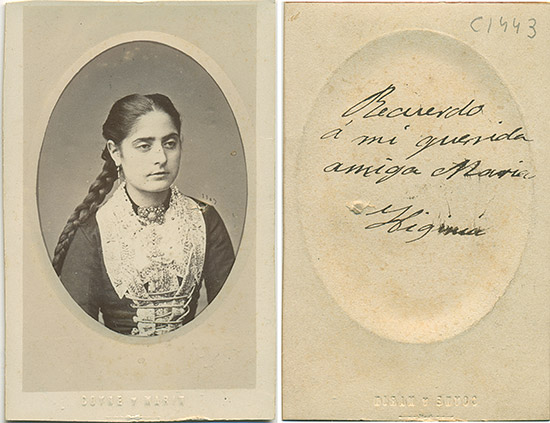
Circa 1880, albumen. CDV (9.8 x .3 cm), Coyné y Marín, Pamplona.
Bust of a woman enclosed in an oval in relief. Reverse with dedication "In memory of my dear friend María, Higinia". The photograph is notable for the long, thick plait that the photographer has placed over the sitter's right shoulder to show her off, and the embroidered stripes on the bodice. Note the elaborate and tight procedure tying of the doublet at the front. The woman wears a four-part ribbon at her throat, typical of Roncal dress, tied around her neck with a black velvet ribbon. This headdress is called a 'cross' (the last piece is a Greek cross) or bitxi. In addition, although it is not clearly visible, he wears a necklace with several loops. On the left shoulder is the numbering of the cliché that was kept in the photographic cabinet for making new copies if the client required them.
The studio of Anselmo Coyné and Valentín Marín was one of the first photographic establishments set up in Pamplona, together with the studio of the two partners Leandro Desages and Domingo Dublán, and the more unknown studio of Domingo Erneta. The studio was active from 1866 to 1881, although Coyné moved to live in Saragossa in 1874. In this city he became position of the important cabinet of Mariano Júdez, becoming a partner with his widow, re-founding the studio as "Coyné" and achieving an important fame continued by his son Ignacio. The Coyné y Marín studio, also known in its early stages as "Fotografía Pamplonesa", was the first photographic establishment to be set up at place del Castillo, a place that from then on became emblematic for the most important photographers in Pamplona.
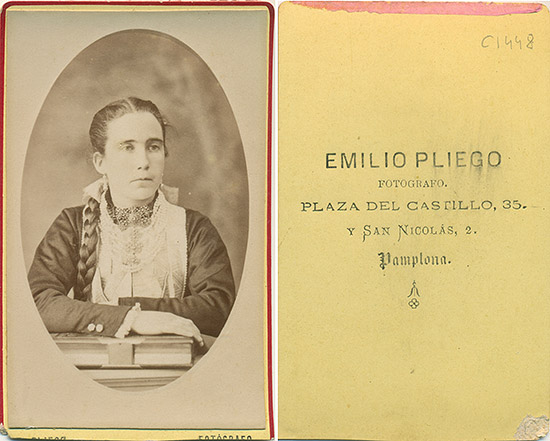
Circa 1885, albumen. CDV (10,2 x ,4 cm), Emilio Pliego, Pamplona.
Bust of a woman enclosed in an oval, leaning against a photograph album. In the image, as in the previous photograph, the long, thick braid at the front, the large ribbon tied at the beginning of the braid and the large jewel or four-piece cross hanging from the neck stand out. She also wears a necklace of several strands of white beads around her neck. She wears a bodice with stripes of braid.
The photographer Emilio Pliego was associated with other photographers before setting up his own studio. We have evidence of association with Leopoldo Ducloux, who had recently arrived in Pamplona around 1876, and with José Roldán, probably continuing the studio left by Coyné y Marín around 1881. Emilio Pliego's solo establishment was located at no. 35, place del Castillo and became one of the most prestigious in the city, one of his specialities being children's portraits. In 1887 he moved to No. 22 of the same place del Castillo. Emilio Pliego ran his business until 1922.
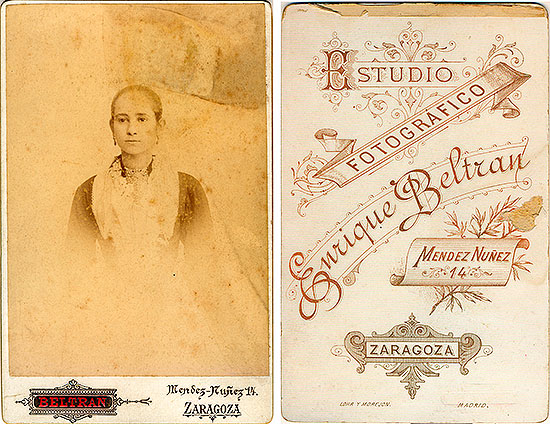
Circa 1890, albumen. Cabinet (16,5 x ,6 cm), Enrique Beltrán, Zaragoza.
Bust of a woman with blurred edges. The photograph sample is badly damaged due to fading of the colour, colour fading to sepia and stains on the surface. The severe damage to the photograph makes it difficult to study the clothing. The sitter wears a large four-piece cross and a multi-strand necklace around her neck.
Enrique Beltrán, together with Anselmo María Coyné, was one of the most famous photographers of the end of the 19th century in Zaragoza. He founded his studio around 1885 in Calle Méndez Núñez no. 14 until 1903, when he transferred it to the photographers Cortés and Antolín.
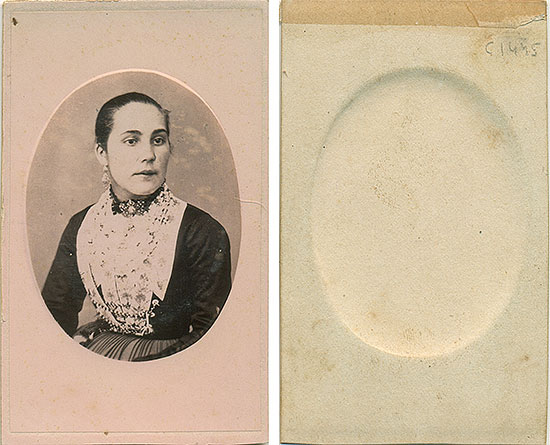
Circa 1865-1870, albumen. CDV (10.0 x .0 cm), Anonymous (probably Ferdinand Bérillon), Bayonne, France.
Bust of a woman enclosed in an oval in relief. As in most of these portraits of female busts, we can see the large jewel subject with a four-piece cross hanging from her neck and a necklace with several strands. It is also worth noting the very tight waist and the large number of pleats that emerge from the skirt.
We do not know the author of this photograph, but as it is most probably the same person as in photograph no. 5 and comes from the same photographic album, we think that the photographic studio may be the same: Ferdinand Bérillon in Bayonne.

Circa 1865-1870, albumen. CDV (10,5 x ,3 cm), Ferdinand Bérillon, Bayonne, France.
Woman photographed full-length, standing, with her left arm resting on the back of a luxurious chair and her right arm holding a fan. A large curtain and a table with books behind the chair occupy the entire right side of the photograph, contrasting with the simplicity of the left side, with the carpet and bare wall separated by a wide, simple skirting board. The woman depicted is the same woman and is wearing the same clothes as in photograph 4. Note the large number of pleats on her dark-coloured skirt.
The Parisian photographer Ferdinand Bérillon had a photographic studio in the arcades of the new bridge no. 1 in Bayonne and a branch in Biarritz (place de la Mairie). He became famous for his numerous portraits of Carlist fighters, including the Carlist pretender Don Carlos, his family and the priest Santa Cruz. His works are dated between 1863 and 1890. The presence of portraits in Roncal costume in this studio, so far removed from the villages of Roncal, is striking. We can speculate, as we shall do in photographs 10 and 11, that this may be due to emigration, although it could also be because the photographer had moved to nearby towns such as Pamplona or Sangüesa. There is evidence of work by this photographer in Bertiz, photographing the Carlist royal family in 1875.
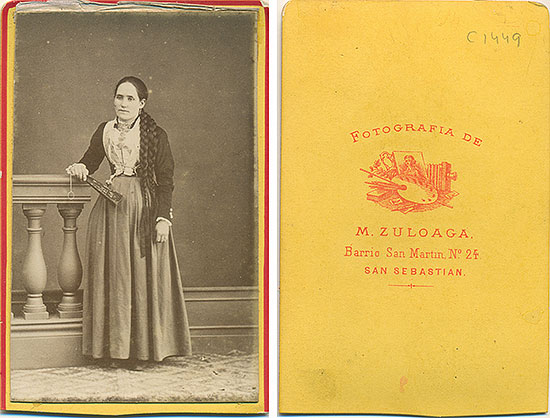
Circa 1870-1875, albumen. CDV (9,8 x ,4 cm), M. Zuloaga, San Sebastian.
Woman photographed full-length, standing, holding a fan in her right arm, which she rests on a balustrade as the only ornament in the scene. Her two long, thick braids are shown together at the front, ending in two narrow ribbons that fall, lengthening the length of the braids. The skirt sample has pleats, but far fewer than those shown in photograph 5.
I have not been able to locate data about this photographic studio located in the San Martín neighbourhood of San Sebastián.
The reverse of the photograph shows the name of the photographic establishment, using a rather simple typeface, and the presence of an anagram representing the painter's palette and a camera enclosing a portrait.
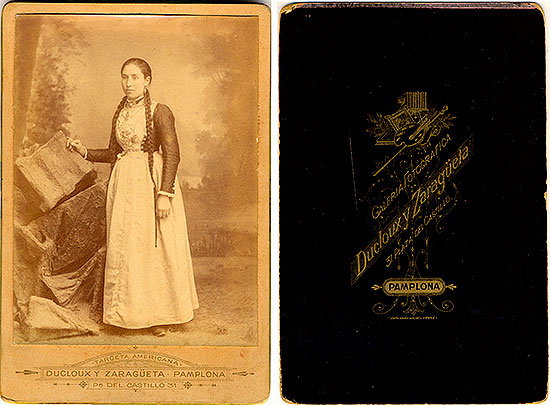
Circa 1887, albumen. Cabinet (16.0 x .8 cm), Leopoldo Ducloux and Agustín Zaragüeta, Pamplona.
Woman photographed full-length, standing, resting her right hand on simulated rocks. The background is a backdrop of a wooded landscape. The woman has two long braids that fall in front of her, one on each side of her body. They end in a narrow ribbon that falls, increasing the sensation of the length of the braids. The skirt, unlike those seen in photographs 5 and 6, has practically no pleats and sample is a much lighter shade.
We know the identity of the sitter, Felipa Orduna from Roncal, and it is probably one of the photographs taken on the occasion of her wedding to Eugenio Garjón from Roncal in 1877.
The Frenchman Leopoldo Ducloux seems to have opened a solo photographic studio in Pamplona in 1872 (place del Castillo nº. 31). Between 1876 and 1879, the photographer Emilio Pliego also worked in his studio. It is not known for certain when the association between Leopoldo Ducloux and the Donostian Agustín Zaragüeta began, probably at the beginning of the 1880s, but it did not last long as in 1887 the former left Pamplona to move to San Sebastián. Agustín Zaragüeta continued the business alone until 1920, when he was replaced by his son Gerardo. Agustín Zaragüeta's programs of study together with those of Emilio Pliego and José Roldán were the three most important and longest-lasting photographic offices in Pamplona in the 19th century.
The reverse of the photograph shows the complexity achieved in writing the name of the establishment and an anagram very similar to the one in the previous photograph (photograph 6) with a painter's palette, a camera and a portrait in between the two.

Circa 1890, collodion or direct blackening gelatin. Cabinet (14,6 x ,0 cm), Emilio Pliego, Pamplona.
Woman photographed full-length, standing, slightly turned to her left and looking to the right. She is holding a folded mantilla with her left arm. The way she wears her skirts stands out, showing the inner skirt as the upper skirt is tucked in the back, a fact that is not usual in photographs of this period. It is remarkable in the photograph the total absence of decorative objects or supports that set the scene of the portrayed.
As we have already mentioned, Emilio Pliego's studio was one of the most important and long-lasting of the cabinets established in Pamplona in the 19th century.
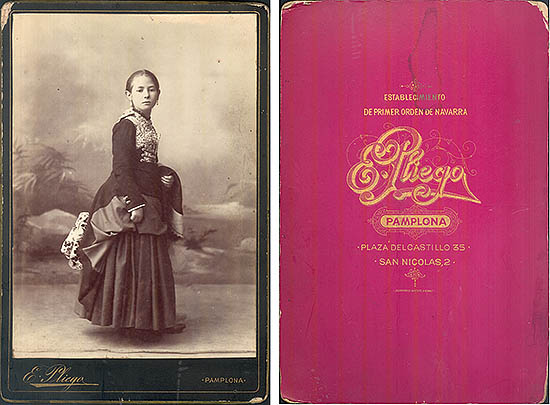
Circa 1890, albumen. Cabinet (16,0 x ,7 cm), Emilio Pliego, Pamplona.
Young woman or girl photographed full-length, standing turned to the left and looking at the camera. She is holding a folded mantilla on her left arm. She is wearing a double skirt, the lower or bottom skirt with many pleats and the top skirt tucked in at the back. The large printed ribbon that seems to hang from a long plait is also noteworthy.
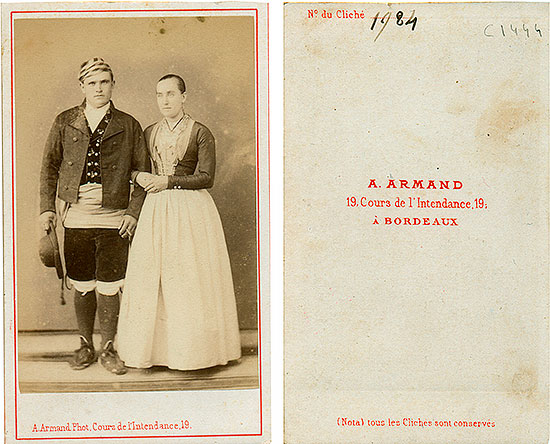
Circa 1865, albumen. CDV (10,6 x ,3 cm), A. Armand, Bordeaux, France.
Male and female couple photographed full-length, standing. He is looking at the camera, wearing a scarf wrapped tightly around his head and holding a large hat in his right hand and what looks like a cigarette in his left hand. She looks to her right and clutches the arm of her partner, most likely her husband. She is wearing a very light pleated skirt. She does not appear to be wearing the typical ribbon-and-cross stifler used in Roncal costume.
We have not found many data of the studio of A. Armand who, according to the French National Library Services , was active in Bordeaux at 19 Cours de l'Intendance street between 1863 and 1876.
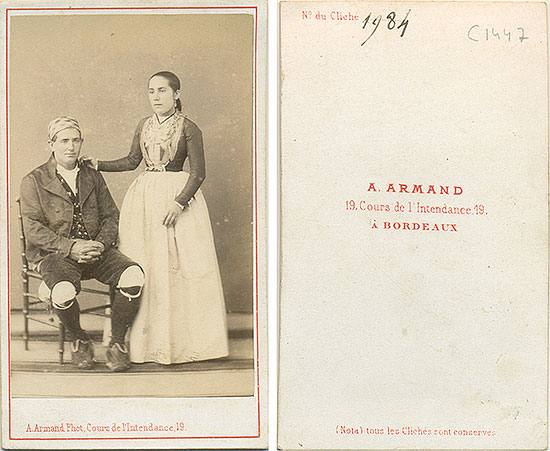
Circa 1865, albumen. CDV (10,5 x ,3 cm), A. Armand, Bordeaux, France.
Male and female couple photographed full-length. The man is seated facing forward in a chair and she is standing with her right hand resting on her partner's left shoulder. He appears to be looking at the camera and is wearing a large printed scarf tightly wrapped around his head, while she is looking to his right and holding what looks like a fan in her left hand. She is wearing a very light pleated skirt and does not appear to be wearing the typical ribbon-and-cross stifler.
There are several striking features in this and the previous photograph (numbers 10 and 11). Both were taken in an establishment a long way from the Roncal Valley, in the French city of Bordeaux. Both have the same cliché issue on the back, which indicates that they were taken at the same photographic session using the same cliché. Finally, the two couples portrayed appear to be wearing the same costume, both men and women. It should also be noted that Bordeaux was the main port of departure for the great wave of Basque-Navarre emigration in the second half of the 19th century, mainly to the American countries of Uruguay and Argentina. All these peculiarities lead us to conjecture the hypothesis that we are looking at two couples of emigrants from Roncal who, as a souvenir for their families, had their portraits taken in the costumes of their valley just before leaving Bordeaux for America.
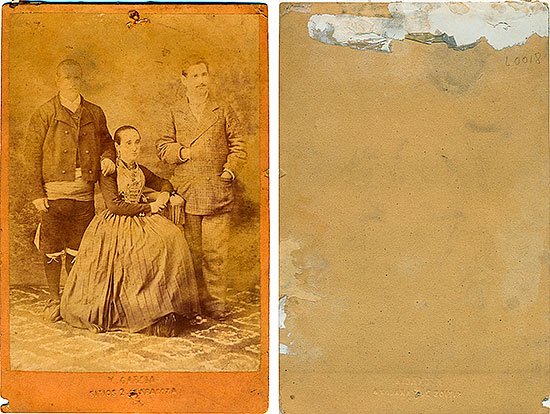
Circa 1864, albumen. Cabinet (16,5 x ,9 cm), Marcelino García, Zaragoza.
Photograph with two men standing and a woman sitting in the middle. All three are looking to their left. The man on the left and the woman are both dressed in formal dress. He wears a black doublet and holds a hat in his hand. She wears a large pleated skirt. The other man wears conventional mid-19th century dress.
Given the provenance of the photograph, it is most likely that they are Pedro María Gorjón and his wife Bernardina Eder from Roncal, possibly photographed on the occasion of their wedding in 1864. We speculate that the other person dressed in the conventional manner may be Pedro María Garjón's cousin, the Roncal tenor Julián Gayarre.
The photograph shows considerable fading of the image, probably due to years of exposure to the effects of natural light; it appears to have been nailed to the wall, as evidenced by the central hole in the top of the photograph.
Marcelino García Orga's photographic studio was one of the first programs of study in Zaragoza, along with Hortet and Júdez. It is recorded as early as 1865 in Calle Sitios no. 2. He received the encomienda de Isabel la Católica in 1882 and in 1883 he moved to Barcelona. The use of cardboard with a strong orange hue as a support for the photographs is striking. We do not know the reasons for its use, although it may have been a cardboard of leave quality that made procedure cheaper. The size of this photograph is also noteworthy, as it is the same size as the Cabinet at a very early date.
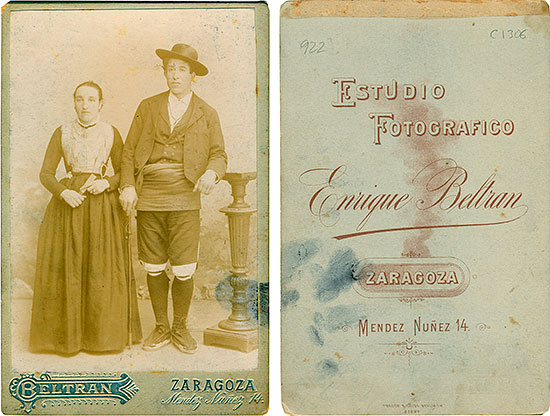
Circa 1890, collodion or direct blackening gelatin. Cabinet (16,5 x ,7 cm), Enrique Beltrán, Zaragoza.
Male and female couple photographed full-length. He is wearing a wide-brimmed hat (it does not look like the typical short-brimmed hat used in Roncal dress today), a black waistcoat and jacket, a large sash, espadrilles and in his right hand a walking stick. She wears a dark pleated skirt and holds a fan in her hands.
The photograph sample shows strong image fading typical of collodion and gelatine direct blackening processes.
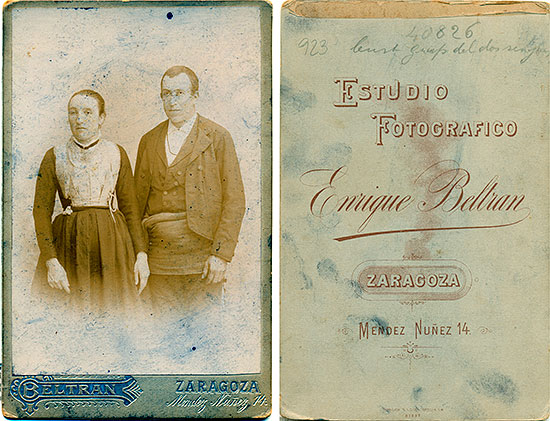
Circa 1890, collodion or direct blackening gelatin. Cabinet (16,5 x ,7 cm), Enrique Beltrán, Zaragoza.
Male and female couple photographed half-length. This is the same couple as in photograph 13, probably on the occasion of their wedding.
The photograph sample shows strong image fading typical of collodion and gelatine direct blackening processes.
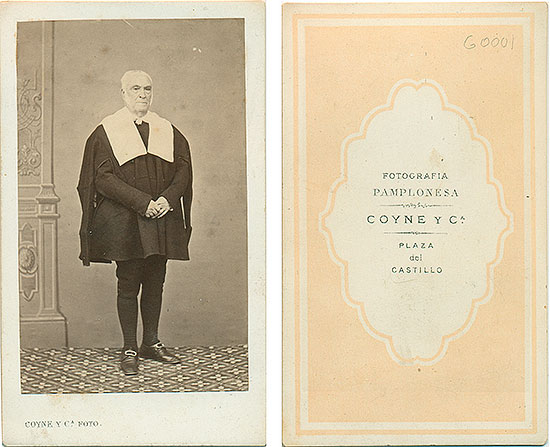
Circa 1867, albumen. CDV (10,4 x ,4 cm), Coyné y Cia, Pamplona.
Man photographed full-length wearing a black cape and white flannel. The capote and valona was the costume worn by men for attend to mass or important meetings. Today it is still worn at certain official events by the municipal authorities.
We know the identity of the person photographed, the mayor of Roncal, Luis Ochoa (1786-1872), married to M.ª Estefanía Gambra, owner of Casa Gambra.
ALLI ARANGUREN, J. C., La Mancomunidad del Valle de Roncal, Pamplona, Government of Navarre, 1989.
BAJAC, Q., The Invention of Photography. La imagen revelada, Barcelona, Blume, 2011.
DOMEÑO MARTÍNEZ DE MORENTIN, A., "Una aproximación a la fotografía y a los establecimientos fotográficos de la Pamplona del siglo XIX". VII congress General History of Navarre. Príncipe de Viana n.º 254, 2011, pp. 337-365.
GARCÍA CAMÓN, M. J. "Anselmo Coyné and Valentín Marín, pioneers of photography in Pamplona (1866-1881)", Príncipe de Viana, no. 274, 2019, pp. 673-721.
GARCÍA FELGUERA, M. S., "Escondidos bajo la tela negra", in conference proceedings del II conference sobre research en Historia de la Fotografía. 1839-1939: Un siglo de fotografía, Zaragoza, high school Fernando el Católico, 2018, pp. 12-36.
HERNÁNDEZ LATAS, J. A., "El enigma 'Ramos Zapetti'. Nuevas aportaciones documentales y gráficas sobre el supuesto inventor español de la fotografía", in conference proceedings del I conference sobre research en Historia de la Fotografía, 1839-1939: Un siglo de fotografía, Zaragoza, high school Fernando el Católico, 2017, pp. 10-38.
HUALDE, F., Indumentaria roncalesa, Pamplona, Lamiñarra, 2013.
IDOATE, F., "Crisis y agonía del traje roncales", Rincones de la historia de Navarra, vol. 1, Pamplona, Diputación foral de Navarra, 1954, pp. 389-396.
IDOATE, F., "Defensa del traje roncalés", Rincones de la historia de Navarra, vol. 3, Pamplona, Diputación foral de Navarra, 1966, pp. 533-537.
IDOATE, F., La comunidad del valle de Roncal, Pamplona, Diputación Foral de Navarra, 1977.
KOSSOY, B., Hercule Florence. El finding aislado de la fotografía, Madrid, Chair. Grandes Temas Collection, 2017.
MESTRE I VERGÉS, J., Identificación y conservación de fotografías, Gijón, Trea, 2004.
PAVAO, L., Conservación de colecciones de fotografía, Granada, board de Andalucía and Ed. Comares, 2001.
RIEZU BOJ, J. I., "El traje tradicional roncalés en documentos notariales del valle de Roncal", Cuadernos de Etnología y Etnografía de Navarra, n.º 87, 2012, pp. 155-212.
RIEZU BOJ, J. I., "Justillos y jubones roncaleses", Cuadernos de Etnología y Etnografía de Navarra, n.º 93, 2019, pp. 7-43.
RIEZU BOJ, J. I., News about a photograph of Roncaleses from 1889Catedra de Patrimonio y Arte Navarro, University of Navarra, piece of the month on the web, July 2016.
RIEZU BOJ, J. I., Roncal in black and white: photographers in the Roncal valley lecture series de la Catedra de Patrimonio y Arte Navarro; En torno al patrimonio cultural en el valle de Roncal, University of Navarra, Roncal 2 September 2017.
RIEZU BOJ, J. I., Unpublished photographs by Domingo Erneta. One of the first photographic programs of study of Pamplona.University of Navarra, piece of the month on the web, January 2019.
RIEZU ELIZALDE, O., Almadías para la armada. Pedro Vicente Gambra y la explotación de los bosques del valle de Roncal (siglo XVIII), Universidad de Cádiz, work Fin de Master inédito, 2019.
ROMERO, A., La fotografía en Aragón, Zaragoza, Ibercaja, 1999.
VV. AA., Fotografía. The whole story, Barcelona, Blume, 2013.
